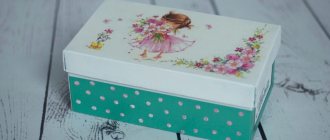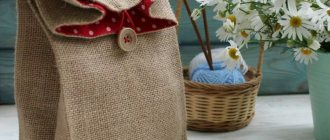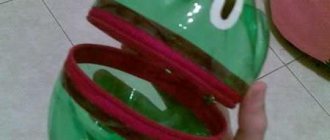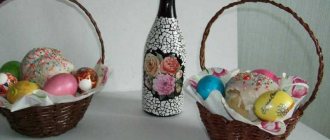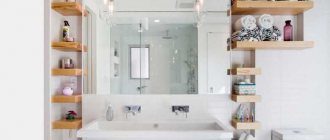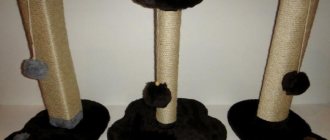Often, after buying shoes, we are in no hurry to part with cardboard boxes. Quite roomy and moderately durable packaging can always be used in everyday life. This is a great place to store all kinds of sewing and craft items.
In such boxes you can even store children's toys, which so often do not have enough space on shelves and in cabinets.
Organizer out of the box
An original organizer for papers, writing instruments, and kitchen spices can be made from a shoe box. Remove the lid, find the center of the long sides. Make angled cutouts on the sides, then carefully bend the bottom of the box in half to become the center wall of the double organizer.
To make an even fold, draw a knitting needle or the blunt end of scissors along the previously drawn line. Now you can carefully draw a fold along the ruler.
We bend the workpiece and glue the sides. We cover the inside of the organizer with paper or fabric. We cover the outer part with a primer.
Now you need eggshells. It needs to be washed with soap and cleared of the inner film. Apply PVA glue to the surface of the box and carefully glue small pieces of eggshell. We get the original surface. To be sure, we pass the brush with glue over the surface again.
Decoupage of boxes with your own hands is an interesting activity that takes a little time, but as a result you get original interior items. After trying it once, you won’t want to throw in the trash something that, after a little modification, will adequately decorate your home.
What to buy for creativity?
Before you decoupage the box with your own hands, you should stock up on all the necessary materials and tools. During the work you will need:
- Cardboard shoe box;
- Decoupage cards or napkins;
- Acrylic primer;
- Glue for decoupage;
- Brushes with soft and hard bristles;
- Sponges;
- Masking tape;
- Fixing and finishing varnish for decoupage;
- Scissors;
- Fine-grained sandpaper;
- Iron;
- Paints;
- Stain.
Step-by-step tutorial for beginners on decoupage of a cardboard box
For the master class to be successful, you must first prepare the materials. You can decorate an ordinary box yourself at home as shown in the photo. For this you will need:
- Pre-printed drawings or napkins, photographs and other ornaments on paper;
- Water;
- Instant coffee (if you need to age our decor);
- PVA glue;
- Acrylic lacquer.
Detailed work progress for beginners in needlework
To begin, sprinkle some sheets of paper with water and then gently spread instant coffee over them. After this, lay the sheets on the table and let them dry. After the sheets have dried, tear them into pieces, but they should not be very small. Cut out pre-printed figures (drawings). To decoupage a cardboard box, clean the surface of the box from excess elements. Glue the torn piece of paper to the surface of the box and coat the top with the solution you made.
Pay special attention to the edges. Glue the entire box like this, and glue the cut out figures on top. Let the box dry, and then, if desired, you can coat it with acrylic varnish to add shine.. See the video for an example (they decorate a wooden box there, but the situation is the same with thick cardboard)
See the video for an example (they decorate a wooden box there, but the situation is the same with thick cardboard).
Crackle effect
New methods and ideas for decoupage boxes appear almost every day. The creative impulses of masters force them to look for ever new methods of decoration, opening up new facets and possibilities.
Decoupage on eggshells, the so-called crackle effect, gives products an unusual, absolutely unlike anything else look. This method of decorating surfaces requires patience, accuracy and perseverance from the performer.
But the result obtained is well worth the effort expended. If you want to do just this kind of decoration, then in addition to the above items you will need to purchase:
- PVA construction adhesive;
- Acrylic paints;%
- Tweezers;
- Metal effect paints;
- Eggshell.
No less interesting is decoupage with a craquelure effect. Cracks spreading across the surface give the products an aged appearance.
Master class on decoupage of a cardboard box
Creative people know that an original thing can be made from any seemingly ordinary or already unnecessary item. So, for example, an old cardboard box that wastes space and collects dust can be turned into a beautiful box. We offer step-by-step instructions on how to do this.
You will need:
- cardboard box;
- paper napkins;
- PVA glue;
- scissors;
- brush;
- acrylic lacquer.
First of all, you should prepare the basis for your future box. An old shoe or gift box will do.
It is not recommended to use colored cardboard, as the design on it may be difficult to see when finished. It is also undesirable to use gloss because the glue will not adhere well to it.
Once you have selected a suitable box, you should clean it of dust and dirt and repair any tears or other damage.
Decoupage is somewhat similar to appliqué, so we will apply the design in a similar way. Ordinary paper napkins with a beautiful pattern are best suited as an applique item. There are other options, such as a decoupage card, but for your test creation, it's better to use a more affordable option.
Select several napkins with the same or different designs and cut out the desired sections.
Take your time, act slowly and carefully so as not to inadvertently damage the surface or design itself. If your child is doing decoupage, do not leave him unattended while he is using scissors.
If you do not want the design to have clearly defined contours, you can tear the napkins with your hands instead of cutting them. Due to the torn edges, the napkin will lie more smoothly on the surface and blend into the background.
When you have decided on the future picture that you want to make from napkins, you can proceed to the next step. This type of paper is already quite thin, although it consists of 3 layers, but for decoupage you only need the top one - colored
Carefully separate it from the bottom two. If you can't do this because the edges are uneven, remove the layer before cutting out the design.
Next, we proceed directly to decoupage. First of all, it is worth noting that this decoration technique differs from conventional applique in that the glue is applied not to the surface that is being coated, or even to the reverse side of the element that needs to be glued, but on top of it.
It works like this: first you should place a section of the napkin on the place of the box where you want to place it. And already on top of it you apply glue with a brush. There is no need to rush, as the napkin, due to its structure, can tear and stretch, which will lead to the design simply deteriorating.
Gently move the brush from the center to the edges, and repeat this operation until the paper fits tightly to the cardboard.
Repeat this step until you have completely covered the box.
The cover may be a different color, have a different pattern, be only partially covered, or not covered at all. Don't limit your imagination, create the decor that you like.
After the work is completed, you need to wait until the box is completely dry and cover everything on top with acrylic varnish.
The finished decor item can be further decorated with stickers, artificial gems, decorative ribbons or dried flowers, or covered with patterns or designs.
A dusty old box has become an elegant box, which is suitable for storing valuables and for interior decoration. And a gift packed in such a box will be even more valuable to the person you give it to.
Containers for storing jewelry
In order not to lose even a small decoration, it is better to use a box made of solid material: wood, tin or, in extreme cases, plastic. Strong round cardboard boxes are also suitable, since there are no connecting seams at the bottom that could easily open.
NOTE!
Varnish for decoupage - advice from experts on choosing varnish and features of its application (85 photos and videos)- Rice paper for decoupage - features of use, selection tips and combination options
- Why install electric underfloor heating?
To make the storage box look like an expensive decoration, it is better to cover its inside with velvet, cream or silver fabric.
The inside of the lid can be decorated with a napkin with a repeating floral print, and on the outside you can glue images with royal lily patterns, plants or the decorations themselves.
How to decorate?
If the desire to master decoupage arises suddenly, and you have a suitable object at hand, anything can serve as a material for coating. Most often these can be paper or fabric images that match the style and color.
Paper
Most often, paper covering is used for decoupage. These can be specially designed decoupage cards, any multi-layer napkins, newspapers, pages of magazines, books or other printed publications. The main difficulties for a beginner are related to thickness and density. There is nothing worse when paper stretches, wrinkles, or tears. On poor quality paper, fibers and other inclusions can be seen in the finished product. If you use separate elements rather than a wide canvas, thick paper will make it difficult to mask the joints and borders.
For decoupage you need the following components:
- shoe box;
- napkins with a pattern;
- PVA glue;
- primer and paints (acrylic);
- brushes (narrow and wide) or sponge;
- varnish
Popular articles Postcard panels with 3D effect
Let's look at the progress of the work.
- First, you need to strengthen all the weak points of the cardboard box. This primarily concerns corners and folds. For this you need pieces of masking tape.
- Then all external sides must be coated with a primer, dried and all irregularities must be sanded well. The number of layers depends on them. As a result, the surface should be perfectly flat.
- After complete drying, you can begin painting. The background color should be in harmony with the selected image. The inside of the box and the lid also need to be painted - to match the external background or any other (can be contrasting).
- Then you need to select a picture or cut out a separate fragment. Only the top layer of the napkin should be separated. The design can cover the entire box, just the lid, one or more sides to choose from.
- Next comes the most important stage - gluing the selected image. We apply it to the box, grease it with glue and smooth it thoroughly to avoid swelling and wrinkles. If you wish, you can make small adjustments. For example, paint details, shade the edges or the remaining space. At the bottom you can lay a proportionate sheet of cardboard, decorated using the same technique.
- Let the drawing dry and secure with several layers of varnish.
You will learn more about decoupage of a box using napkins by watching the following video.
Fabric
In addition to paper, you can use fabric. Moreover, you can make quite unusual combinations with it.
Let's consider a master class on a fabric design option.
- Prime the box. If the fabric is opaque, the parts to be glued over the primer do not need to be painted.
- Take measurements from the box. Mark the pattern on the canvas. To make the edges look neater, allowances are needed, which should be ironed inward.
- All fabric parts, even if they are small, should be ironed well.
- Then we lay out the workpiece. A layer of glue should be applied to it, as well as to the box.
- Then we start gluing the fabric. It should be smoothed out well, moving from the middle to the edges.
Other decorative elements
Decoupage boxes can be supplemented with ribbons, ropes, twines, as well as all kinds of beads, shells and similar materials.
Decoupage goes well with other techniques. The image can be applied not to a smooth surface, but to a textured one. For this, in addition to the items already listed above, you will need an ordinary eggshell. It should be washed and removed from the inner film. You will also need tweezers, a stick and a glue brush.
Step-by-step instructions for implementation include several steps.
- The first stage consists of gluing the shell. It can be glued in small pieces. Or, to save time, take larger pieces. The selected part of the shell must be coated with glue on the inside, and then placed in the desired place and pressed. The cracked pieces must be slightly moved apart to avoid overlapping each other. It is also better to apply glue on top of the shells.
- After the entire box is covered with the shell, it is painted with acrylic paint - white or any other in accordance with your plan. To avoid unpainted areas, there may be several layers.
- Then you can start decoupage. Cut out the required fragment of the napkin, separate the top layer, apply it and lubricate it with glue. The final layer will be a varnish layer.
Gift box: decoupage on wood
Wood is often used as a material for decoupage.
The best gift is one made by yourself. If you want to please your loved ones and give them an unusual gift, then decoupage a wooden wine box.
Such a gift is relevant for any holiday, and its design will not be difficult.
The technique for performing it is the same as described above, only with a few additions:
- a sanded wooden box should be treated with alcohol to degrease the surface;
- It is better to put sawdust and cut gift paper inside the box so that the bottle does not hit the walls.
Tools and materials that are necessary to perform work using the decoupage technique
- Hard brushes for applying glue and varnish;
- semi-rigid brushes for applying primer and acrylic base;
- soft artistic brushes for applying background and decorative paintings;
- spatula, palette knife or plastic stiletto from plasticine for surface treatment;
- fine-grain sandpaper or other similar abrasive material;
- sponge;
- scissors (optimally manicure scissors);
- glue: PVA or special decoupage;
- varnish: special decoupage or regular parquet (depending on the nuances of the structure of the base surface);
- paints: primer, acrylic, sometimes gouache;
- file (in cases where an additional dense base is required to transfer the design to the item being decorated);
- decoupage napkins or cards;
- various additional decorative elements: ribbons, lace, beads, clay figurines, foil, gold leaf and so on (everything that the master’s imagination suggests).
Preparation is the basis of everything
In order to start creating, you need to prepare a box:
- Tape the folds and corners with paper or masking tape, because... If you neglect this in the future, the appearance of the product may become untidy.
- Prime the surface in 3 layers. After applying each layer, you must wait for it to dry completely and treat it with an abrasive material.
- Proceed to creating the background: apply acrylic paint of the selected color.
Decoupage of a wooden or plywood box. Step-by-step instruction
Wood and plywood perfectly absorb dyes and adhesives and are a good basis for decoupage. The only negative is their fibrous structure, which can spoil the appearance and prevent the uniform adhesion of napkins and cards. Therefore, an important stage of work is the preparation of a wooden or plywood base.
- Sand the surface of the box with sandpaper or other abrasive material.
- Treat the inside of the box with stain.
- Apply primer, white acrylic paint or stain to the base (depending on the desired subsequent tone of the product).
- After drying, successively apply two or three layers of acrylic paint for the background of the product onto the base. Allow to dry thoroughly. (If stain is used for the background, this item is skipped).
- Apply a layer of glue to the areas on which the picture will be applied.
- Cut out or tear out the required pictures from decoupage napkins, soak them on a file, attach the picture to the placement area on the box.
- Iron the picture thoroughly with a hard flat brush until the air is completely removed and evenly straightened.
- Complete the missing elements and patterns with paints.
- Finish the job by coating the box with several layers of varnish.
- If desired, you can use gold leaf, beads, bows, and sprigs of artificial greenery as additional decorations.
Such a box is useful for storing bulk products in the kitchen, newspapers and magazines in the hallway or in the living room, toys and construction parts in the nursery; for the presentation of wine and cognac bottles, fruits, sweets to guests during the holiday.
The process of decoupage of metal and plastic boxes is generally similar to the process of decorating wood products described above. But it should be borne in mind that the preliminary stage of working with a metal or plastic base is its complete degreasing. It is best to use alcohol for these purposes.
Decorated metal and plastic boxes are convenient for storing small, easily lost items. Metal boxes are also indispensable for storing tools, strong-smelling substances, and medicines. Plastic boxes decorated using the decoupage technique make excellent boxes, flower pots, and containers for spices.
An interesting effect of a single whole with the base can be achieved on wooden, metal and plastic surfaces by implanting a printout. In this case, the pictures from the napkins are transferred to the base not from the back, but from the front side.
Spice box
Any base will do - a medium-sized cardboard, wooden or plastic box.
It is recommended to design the container in Provence style. The combination of white, purple and green, as well as images of French herbs and plants will give the kitchen an atmosphere of coziness and warmth.
Skinning (decoupage boxes)
When I started doing decoupage, I discovered “skin” as one of the main elements of decoration. Previously, I did not attach such importance to sandpaper, but its use greatly changes the work with the product.
So, in order:
1. Regular blank, box. We collect all the necessary materials: primer (or acrylic paint), napkins, brushes, and of course the skin, the heroine of today's series.
First we sand, then prime, sand again, prime - until we achieve sufficient smoothness of the workpiece. Subsequent steps are greatly simplified if the surface of the product is smooth.
2. Apply a decoupage napkin (previously torn along the contour) to a smooth, flat surface. We also decorate the inner surface of the lid with a napkin and cover it with masking tape. for the time being.
3. Apply a layer of dark paint to the places where craquelure is supposed to be applied; this color will be the “background” for the cracks. After drying, apply single-phase craquelure to this layer.
4. While the lid is drying, we begin work on the design of the “body” of the box. We select a suitable color and apply it so that the transitions from the napkin to the surface are not noticeable. And.. right! skinning. with fine sandpaper, gently and carefully, so as not to tear off the napkin and paint. After sanding, we paint over the areas that are exposed. We paint and sand. Even where the napkin has peeled off, it’s not scary, we need the effect of antiquity, we will achieve it. But the extra waves and creases will go away.
Popular articles Options for congratulations on March 8
5. The lid has dried out (we waited more than an hour for the varnish to dry). Apply paint
Moreover, when applying paint to single-phase craquelure, it is important to do it with one stroke, without passing over the same place twice. Then the cracks will be smooth and “tasty” :)
And of course, after drying, we sand it! gently!
6. Paint the product. We finish the bottom, internal surfaces, sides, lid, very carefully selecting the paint and using thin lines to achieve a uniform color. Several times we go through it not even with sandpaper, but with a sandpaper sponge (I forgot the correct name). There is a very fine grain, almost felt sanding. You can take a piece of felt or coarse fabric (such as jeans) for the same purpose.
7. Using a sponge with contrasting paint, paint the inside surface of the box and go along the edges, in places overlapping the decorated surface. The effect of an uneven coating is created, the box begins to “play”, it begins to have a story. There is imperfection in her and that makes her alive.
8. Varnish. The longest stage in all the work. We patch, dry, turn over, patch, dry. We skin it. For the first layer we use sandpaper that is quite coarse, medium-grained. Thanks to this, we remove almost all the varnish :))) And again. We patch, dry, turn over, patch, dry. We rest and leave it overnight. In the morning, everything is done again: sandpaper (fine), varnish, drying. sandpaper varnish drying. ugh. Look like that's it. There are no limits to perfection, but you have to stop sometime. It feels like when you start to like the box in your hands, then the last time is to dry the varnish. It takes a couple of days for it to completely dry to touch. It’s better not to turn over at this time.
9. Done! There's no way to do this without skin. The smooth varnish surface gives the product integrity and completeness. And smoothness is impossible without careful sanding. So don't be lazy to sand!
Decoupage spice box using printout method
For this method, it is better to use plywood blanks, since during the implantation process the cardboard base may delaminate. However, if you work very carefully, you can also decorate a shoe box with decoupage and implantation of a printout.
In addition to the technique given here for implanting a printout “with its face into the varnish,” there is another method: transferring the design to the product using a hot iron.
This technique may seem too complicated for beginner decoupage artists, but if you follow all the steps carefully, you will be pleased with the result.
Master class for beginners on decorating a box using the technique of implanting printouts:
- Sand the box with sandpaper.
- Apply a thin layer of primer, white acrylic paint or stain to its surface and let it dry.
- On top of the primer we apply several layers of acrylic paint of the main color. Let the boxes dry thoroughly. This step does not need to be completed if you used stain to decorate the box.
- We apply several layers of acrylic varnish or special adhesive varnish to the printed motif. We cover the places where the design will be implanted with a thin layer of the same composition and until it dries, we lower the varnished image with its face into the varnish. Leave this structure in this position until completely dry.
- The next day, generously moisten the printout with water and begin to roll all the paper off the product. When you think there is no more paper on the image, dry it with a hairdryer and you will see a white coating, you need to get rid of that too.
- When only a bright image remains on the product, fill in the missing details with acrylic paint.
- Open the box with several layers of varnish and leave it until completely dry.
Despite the apparent complexity of this technique, even a beginner can handle it, the main thing is to follow the described sequence of actions exactly.
Tools and Supplies
Decoupage is a type of decorative and applied art that allows every person to create something truly beautiful using the simplest and most affordable materials. You may not believe it, but most of the tools you need are already in your home!
The decoupage technique for decorating products and decoupage furniture is again at the peak of popularity.
Let's figure out what is needed before starting work.
Tools
- Sharp manicure or medical scissors of a size convenient for cutting out small parts.
- You may also need a utility knife.
- Several types of brushes. If you plan to work with small details, you will need small flat brushes with thin artificial bristles. To apply acrylic paint or primer, a regular dishwashing sponge can be useful, but keep in mind that it creates a rough texture, which is not necessary for every job. To create a smooth surface, a large synthetic brush is required. Thin brushes made of synthetic bristles are suitable for drawing small details on the finished work. It is worth remembering that separate brushes are needed to apply glue, paint and varnish.
- Sandpaper for sanding surfaces during preparatory work or for correcting minor mistakes. Choose paper with fine and medium grain in several gradations.
It all depends on the goals you are pursuing.
Consumables
- Acrylic lacquer. There are many varieties of it on the market. There are both water-based and adhesive-based, with different effects (antique, with glitter, cracks) and finishes (matte, glossy, semi-matte, semi-gloss). Choose a water-based varnish, but the effect and finish should be chosen based on the desired result. Both regular construction varnish and a special one for decoupage are suitable for the job, but this is a more expensive option for advanced craftsmen.
- Acrylic paints, watercolors and pastels for drawing small details or creating additional effects.
- Glue. Craft stores sell jars of special glue for decoupage, but again, it is of no use to beginning craftsmen who just want to try themselves in a new technique. PVA glue from the middle price category (do not take the simplest one for children) diluted with water in equal proportions is suitable.
- Priming. Serves to improve adhesion between layers of glue and napkins.
- Printouts. Thin paper on which a pattern is printed using a laser printer is also suitable for decoupage.
- Napkins. Their varieties are described in more detail in the next section.
Table napkins, which are usually multi-layered, are used as an image.
Tips for thematic and compositional design of boxes
- For products that will be used in the nursery, it is best to use images of fairy-tale and cartoon characters, drawings of flowers and butterflies; the colors should be light and joyful;
- for those boxes that will be used in the kitchen, images of fruits and vegetables, flowers will be optimal;
- for boxes it is best to use common interior design motifs, such as Provence or kitsch;
- for boxes in which gifts will be presented, it is most natural to use motifs and colors that correspond to the gender of the gift recipient: for women, bright, rich colors, patterns and designs are suitable; men will be more pleased with discreet shades and images from the sphere of male interests (cars, weapons, armor, maps, etc.).
Decoupage a box is not too difficult and quite a fun activity. Proper efforts will give things a second life.
Decoupage bottles for beginners: step by step with photos and recommendations
- the simplest and most affordable material from which you can make an original gift. You can buy a bottle of wine or fill the container with your own homemade drink. Luxurious decoration will make an impression in any case.
We have already listed the materials and tools necessary for the work, so we will not dwell on this in detail. The only thing that needs to be added to the list is a windshield wiper. They pre-treat the bottle, which has been cleared of labels.
Bottle decoupage sequence for beginners, step by step with photos:
| Illustration | Description of the stage |
| Applying primer | For priming, you can use acrylic varnish or PVA. The soil should dry well. |
| Making the background | For the background you need to use white or light acrylic paint. You may need to apply two or even three coats to achieve a completely opaque surface. |
| Applying images | The design on the napkin is carefully cut out with scissors. If the background of the picture and the bottle matches, do without scissors and carefully tear off the napkins. To make the design on the print easier to apply, it should be soaked in a plate of water. |
| We fix the drawing | You need to apply varnish over the surface of the drawing. This can be done with a soft flat brush or a spray bottle. You should make sure that the picture is not covered with wrinkles. If necessary, it must be carefully straightened with a brush. |
| Finishing | After complete drying, you can carefully sand minor imperfections in the work. To highlight details, use a brush and dark paint. Once finishing is complete, apply a final coat of varnish. |
Another option for an original design is decoupage of a bottle with tights. Master class on video:
We use napkins to decorate paper products
A cardboard box can be used for anything. And don’t rush to throw away even small boxes. Decoupage of boxes with napkins consists of several stages, and doing it yourself is not difficult. In the photo you see what you can achieve. First you need to prepare the materials.
To get started you will need:
- A small box of any shape prepared in advance;
- Paint (you can use acrylic and oil paints);
- Glue (PVA is suitable);
- Napkin with a pattern;
- Manicure scissors;
- Brushes;
- Sponge.
Let's look at a simple and understandable master class step by step
- To begin with, if the surface of the box is not completely smooth, it needs to be lightly sanded. Sand until it is smooth.
- After this, apply paint to the surface of the box.
- Carefully cut out the design from the selected napkin.
- Place a napkin on the surface of the box (lid or walls) and use a pencil to mark the place where you plan to glue it.
- Now take your paints. You can mix several shades so that they do not contrast too much with the chosen pattern. Then use a sponge to carefully apply paint to the box lid, being careful not to touch the area you have allocated to attach the design.
- After this, apply glue to a clean area of the lid and glue our pre-prepared pattern there.
- You can also cover the outer walls of the box with a colored napkin - at your request.
Plastic box: decoupage
From an unnecessary round jar of salad or mayonnaise, you can make a great box for storing candy, a mixture of spices or craft supplies.
Before decoupaging a plastic box, it is recommended to check its surface for cracks.
For such a craft, you will not have to buy a lot of materials, and therefore there will be no large costs.
Master class on decorating a plastic box:
- Cut out four circles equal to the diameter of the box from white glossy paper;
- Cover the entire surface of the plastic jar with primer;
- Glue circles on both sides of the bottom and lid;
- We prime the side surface of the box and cover it with a strip of decoupage napkin with a pattern you like;
- We decorate the lid of the box with an artificial flower, which you can buy in a store or make yourself from ribbons and corrugated paper;
- We paint the empty spaces in a color that matches the decor and varnish them.
Such a simple box will become a real decoration of the kitchen space.
Containers for storing children's toys
The most practical base option would be a large, durable plastic box. Such copies can be found in furniture stores, for example, IKEA.
The baby is unlikely to like a boring transparent box, so it is worth decorating it using the decoupage technique. You can use prints with your favorite cartoon characters, as well as traditional “children’s” prints - animals, plants, flowers.
Technique for decoupage boxes
You can transfer pictures from special paper for decoupage, napkins with drawings, or you can try to print any image yourself. This will allow you to get a unique design with any picture you like, which you can also draw yourself. You can also print your own photos - such things will be a wonderful gift for loved ones for any occasion.
How to print a design for decoupage
To transfer any picture or photograph onto an item, you can print it on a regular printer:
- Select a picture to print. You can find it on the Internet, assemble it from separate parts or draw it in a graphics editor, and also choose any beautiful photographs. To design a gift souvenir, a great idea would be to scan old photos from a family album.
- Take a sheet of plain paper or photo paper. You can print a picture onto a napkin or a thin sheet of paper - to do this, you will need to glue it to plain paper so that the printer can use it and not wrinkle it.
- Print the image on a printer. Make sure that it is placed in the right place; if necessary, you will have to print it again. It is worth noting that pictures obtained from a laser printer can then be soaked in water, it is easier to glue them, and at the end of the work it will be possible to coat such a box with varnish. If the printer was inkjet, especially with water-based inks, the image may spread and you will have to work with it more carefully.
Popular articles Photo frame
Preparing the paper
There are the following methods for separating a thin top layer with a pattern:
Thinning paper using tape. We strengthen the front part with the picture with transparent varnish (hair product is also suitable). After drying, turn the sheet over and apply a layer of tape, trying to avoid folds and bends. Carefully remove the tape from the excess paper. As a result, a thin sheet with a picture should remain. Using water. Apply a layer of varnish to the image to secure it. If the layer turns out to be too thin, you can apply it in several coats, allowing each of them to dry. Once dry, place the paper in a container of water. After half an hour, take it out and place it face down on a flat surface.
Carefully remove the unnecessary paper layer with your hands. Processing of photographic paper. Coat the front side with varnish and dry
Then place the paper side down on a wet table or board. After 5 minutes, detach the excess paper from the layer with the image: you can pick it up if you peel off the corner of the paper with a needle.
"Mom's Treasures"
Choose napkins or decoupage cards that suit the style and theme. Tear out (do not cut!) the necessary motifs from them, create a preliminary composition.
For beginners, it is more convenient to decoupage boxes using the “file” method. Apply a thin layer of PVA glue to the primed surface of the box, carefully apply a fragment cut out of a napkin, having first removed the lower layers and leaving only the top, thin layer with the pattern.
Place a stationery file or polyethylene on top of the napkin and carefully smooth the pasted fragment, directing movements from the middle to the edges. Iron until all the air is released and the napkin sticks to the box. Glue all the fragments of the picture in the same way.
Now you can use acrylic paints to finish the background and tint the corners to give the box an aged look. All that remains is to coat the resulting box with several layers of varnish and, if desired, add voluminous decor. Now no one will be able to guess what your box was originally.
This way you can decoupage shoe boxes and various packaging boxes.
Step-by-step instruction
Before starting work, the surface of the cardboard box must be cleaned of mechanical contamination. It is enough to lightly sand it with fine-grained sandpaper. Some boxes are coated with a glossy layer, which should also be removed to increase adhesion between the primer and the surface.
- Decoupage a kitchen table with your own hands - how to make a decoration for the tabletop and legs. Master class, video and photo
- Decoupage with rice paper: useful tips and master class on DIY decoration (video + 145 photos)
- Volumetric decoupage technique for beginners: photo and video decor master class. Step-by-step training and tips for choosing ideas for beginners
The folded areas are most susceptible to abrasion. To strengthen these areas of the box, they should be taped with masking tape.
The next step is applying the primer. To do this, use a wide brush with hard, synthetic bristles. You should try to distribute the soil over the surface in an even layer, painting over all gaps and avoiding the formation of “bulges”.
Paint the box with acrylic paint that matches the main color of the pattern on the napkin.
It is easiest to stick decoupage cards and napkins onto flat, even surfaces using a regular iron. This method is suitable for novice craftsmen who are just beginning to master the intricacies of this delicate paper craft. To do this, cover the surface of the box with a layer of adhesive varnish and wait until it dries completely.
- Instructions on how to work with decoupage paper: step-by-step description and mastering the technique of applying patterns and pictures (115 photos)
- New DIY paper decor ideas - 140 photos of new products and interior design ideas for developing craftsmanship
- Beautiful DIY living room decor - the best ideas for decorating and rules for decorating a living room (video tutorial + 120 photos)
Now apply a napkin to the dried surface, cover it with a sheet of clean white paper and gently iron it. Melting under the influence of hot temperature, the glue tightly adheres to the decoupage picture. Excess napkins are cut off with scissors or cut off with sandpaper.
In this way, all surfaces of the box are decorated. Cover all surfaces covered with napkins with a fixing varnish. Distributing it in a thin layer from the center to the edges.
To enhance the decorative effect, the contours of the design are painted over with acrylic paints, adding depth and relief to it.
The edges of the box can be painted with dark shades, applying them with driving movements using a sponge. In addition, the box can be aged by covering individual areas with a thin layer of patina. The product is coated with glossy varnish.
This is how easy and simple beautiful decoupage of boxes with your own hands allows you to turn ordinary packaging into a real work of art.
- DIY wall decor - DIY wall decor ideas. 145 photos of stylish design options
- Review of original bathroom decor ideas - 105 photo ideas on how to correctly implement a special interior design in the bathroom
- DIY stencils for decor - step-by-step instructions on how to make a beautiful stencil. 110 photo ideas for stencils and a master class on its use
Decoupage - a non-standard solution to a standard problem
However, in most cases, shoe boxes have a very mediocre appearance, which can hardly be called aesthetically attractive. Over time, the accumulated packaging gives the room the effect of clutter, causing not very pleasant emotions among the owners.
You can correct this situation with the help of ordinary decoupage, decorating objects of different shapes, sizes, colors and textures in the same style.
The ensemble created in this way can become an accent spot in the interior of the room. Photos of decoupage boxes allow you to get ideas for inspiration.
The abundance of various decoupage cards and napkins makes it possible to choose a picture or even an entire composition, the appearance of which will organically fit into the overall concept. For the kitchen these are drawings with products or flowers. For children's rooms - images of fairy-tale characters or heroes of your favorite cartoons.
However, if you decorate the box with floral motifs in pastel colors, it will take its rightful place even in a living room or bedroom decorated in a country or shabby chic style.
Decoupage is the simplest way that allows novice craftsmen who do not have the skills to draw and paint objects to decorate surfaces.
You can decorate not only boxes in this way, but also:
- furniture facades;
- bottles;
- dishes;
- cutting boards
Decoupage does not tolerate restrictions and there is room for creative experiments and flights of imagination. Even children can cope with this type of creativity. This means that adults can also take up a new hobby without fear. And perhaps very soon the exciting process of creating paper compositions will turn into a hobby.
So, what napkins can be used in decoupage?
1. Ordinary three-layer ones, which are sold in packs in regular stores
or hypermarkets (standard sizes - 33x33 cm). Sometimes you can find really beautiful napkins in such packages (especially before the New Year"). Packages of napkins come with one motif (all the same) or with different ones (4 different designs, 5 pieces for each type. So, I treasure one package with incredibly beautiful autumn napkins like the apple of my eye - the motifs are so successful, they can be glued to any blank, and they will look beautiful everywhere.
A significant advantage of such packaging is the price.
(1-1.5 dollars per package in Belarus).
Considering that in craft stores 1 napkin is sold for 8-10 Russian rubles, then this is really a significant plus. Well, a significant disadvantage is the small selection
. By the way, be careful when buying a set of different napkins. They usually put beautiful napkins on the front and back, but inside you often find all sorts of napkin nonsense that is almost of no use in decoupage
I’ll write separately about perforated edges
, because some beginners are afraid to glue the perforated areas of the napkin. Don’t worry, all this will smooth out when wet if the napkin is of high quality. Well, if it’s of poor quality and something remains after gluing, you can press these bumps into the surface with your fingernail (before varnishing), and they should disappear.
2. Four-layer “handkerchiefs”.
Also sold in stores and also very cheap, dimensions - 21x21 cm. The pros are the same, the cons are the same. By the way, sometimes in such large packs and in “handkerchiefs” there are identical pictures, only different in size. From such a collection you can make some kind of set, for example, several boxes of different sizes or several items for the kitchen - naturally, all in the same style.
3. Very beautiful napkins, which are sold in craft stores especially for decoupage (three-layer). They are sold individually, at 8-10 Russian rubles per piece. Standard sizes are 33x33 cm, sometimes you can find 25x25 cm.
Plus - a large selection.
Indeed, a beginner’s eyes widen from such a choice, and he wants to buy everything at once (this is exactly what you don’t need to do!!!). The downside is the price (10-20 rubles). In principle, if you do several jobs a month, it comes out inexpensively, but you need to take into account that brushes, paints, and varnishes also cost a lot...
By the way, beautiful napkins can and should be brought from abroad. There they are much cheaper, and the choice is huge! Therefore, if your friends ask what to bring you from Europe, feel free to answer: “of course, napkins!”
Single-layer napkins can also be glued, but beautiful ones are rare among them. In any case, the technique for working with them is the same as with all the others, you just don’t need to layer them.
Design options in decoupage style
Using the technique in question, you can decorate various containers - shoe boxes, jewelry, and gift packaging.
In each case, it is recommended to use different prints that correspond to the chosen theme.
DIY box decoupage
For decoupage, you can use napkins that are sold in art stores, or any table, if the pattern suits you, only the top layer with the pattern is used, the bottom two are not needed. Ordinary table napkins make wonderful flower topiaries, as shown in ours.
If you have decided exactly how you want to decorate the surface, let's proceed to the decoupage itself. We cut the napkin into fragments of a suitable size, this can be done arbitrarily, or cut out specific elements and arrange them in the desired order, or cut into pieces, just keep in mind that you should not make pieces larger than 8 cm, they will be much more difficult to work with.
When the napkin is prepared and you have decided on the location of the pattern, apply a small amount of glue directly to the surface of the workpiece, it is better to start from the inside, first the bottom, then the sides.
When gluing the paper, straighten it carefully with your fingers from the center to the edges, driving away the bubbles, you can make folds or smooth it completely, it all depends on your preferences. When the inner space is filled, we apply the same principle to the outer sides; you can glue several layers or slightly overlap, but in this case make sure that the bottom layer is well smoothed.
Lastly, we also decorate the lid, first from the inside and then from the outside, an exception may be when you decide to glue a postcard or a whole sheet of paper on the inside, then do the opposite, first the outer part, and then overlap the bottom of the lid by gluing the whole sheet.
The finishing touch is to cover the applique with a layer of acrylic varnish, this is convenient to do with a soft brush. The varnish protects the decor of the box and gives the composition a finished look. Depending on the purpose for which you prepared the craft, the box can be decorated with ribbon or.
Thus, we have a wonderful craft that can be used to store sewing supplies, office supplies, or anything else; you can also use glitter and paints in the decor to highlight some elements of the pattern.
Materials for work
To decoupage a shoe box, you will need materials and tools that should be prepared in advance. Beginners sometimes forget to buy this or that item, and interrupting the process for a long time often turns out to be disastrous.
You will definitely need:
- Napkins with a pattern for decoupage work. They are easier to work with and the motive is more natural. But if you want to put a photo or personal drawing on the lid, you will have to thin the paper using water and rolling the back side to pellets.
- Acrylic primer.
- It is also better to use acrylic paints for tinting, as they cover the object with a thin, durable film that is resistant to many influences and is quite affordable.
- Glue varnish if you are doing “hot decoupage” or regular PVA.
- Finishing varnish. It can be purchased at craft stores or construction supply outlets. Suitable acrylic, polyurethane, alkyd. To age the surface, buy craquelure or patina.
- You will need brushes, a roller, fine sandpaper and a foam sponge.
Step-by-step instructions for decoupage using the “hot method”
First, we will give a master class on decoupage boxes using an iron. For beginners who are just starting to decorate objects with napkins with their own hands, this is the easiest practice.
- The reinforced box is covered with several layers of soil. It is better to do this with a roller or sponge, rolling or “wetting” each corner. Each coat must be completely dry before applying the next. When the soil has formed a strong frame, take the sandpaper and thoroughly sand it to a smooth, almost shiny state.
- Even if you cover the walls with a continuous pattern, staining cannot be avoided. Paint the box several times to match the main background of your motif. Let it dry and clean up any leaks.
- The next step is to try on the napkin on the working side of the future box. Beginners are afraid to trim too much and don't do it. This is also possible, but then the excess edges will have to be carefully trimmed afterwards.
- Take a wide soft brush or a piece of foam rubber and coat the work wall with adhesive varnish in an even layer. Let the glue dry.
- Remove the protective layers from the napkin. There may be two or three. Place on glue.
- Preheat the iron until warm. It should not burn the paper, it is better to check this elsewhere. Iron the napkin slowly, but also without stopping for long.
- Apply one coat of varnish to seal the work.
- Proceed with the remaining sides of the box. Here everything needs to be done identically to the first one. Bend the corners carefully to avoid wrinkles.
- The upper part of the lid can be designed differently by cutting out individual motifs from the design and gluing them scattered. It is interesting to decorate empty spaces with glazing - applying paint layer by layer in a chaotic manner.
- The last step is to carefully varnish the box several times. Each housewife implements ideas for additional decoration - aging, patination - according to her own taste.
Decoupage boxes using the usual method
For standard decoupage you will need regular PVA. In this case, all work is carried out in a similar order, except for applying the drawing itself. You need to free the napkin from the protective layers, carefully lay it or the torn out motifs on the surface and begin gluing directly on the front side of the napkin. After drying, the drawing is varnished several times.
Cardboard box decoupage is an easy way for a beginner to practice learning the technique. But the result can be a stylish interior item, pleasing with its beauty and functionality.
What is decoupage
Decoupage is not a new type of creativity that a lot of people are interested in today. Over the past 10 years, thousands of handicraft stores have opened in our country, where you can buy everything for decoupage, including the boxes themselves! In the past, they pasted on pictures that they drew themselves or cut out from wherever they had to, and applied photos. Today, boxes are decoupaged with napkins or special cards. Ready-made pictures on napkins can be ordered online in large quantities, and learning creativity is quite possible through video master classes. Decoupage courses are open in many cities. Any person can learn this art, regardless of his skills and knowledge.
Cardboard box
Useful jewelry box
Having prepared the box of the required size, you need to coat it with a primer and paint it in the main color. It’s better not to paint with a brush, but to blot it with a sponge, so the surface will become more impressive. Then you need to take the eggshell, wash it with soap, remove the film and dry it. Then glue small pieces of it onto the surface of the box coated with PVA glue. Also coat the top with glue.
Then apply fragments of napkins to the surface and cover with several layers of varnish. It will be beautiful if the inside of the box is upholstered with knitwear. You will get a stylish jewelry box. This box with soft walls inside can also be used to store Christmas tree decorations. It can also be given as a New Year's gift along with toys to please friends or colleagues.
master classes with step-by-step descriptions and video lessons
In any house you can find some kind of box in which its inhabitants put all sorts of useful household items. Often this role is played by an old shoe box, which is stored in the closet, away from prying eyes, due to its unsightly appearance. But if you decoupage such a shoebox, it can easily take a prominent place in the living room or bedroom. So, let's learn how to decoupage boxes.
In our article you will learn how to decoupage a shoe box: a master class with step-by-step instructions, photos and videos will help you with this.
Shoebox Makeover
For decoupage we will need the following materials:
- shoe box
- napkins for decoupage
- white cardboard
- PVA glue
- glue Moment crystal
- glue stick
- brushes
- file
- sponge
- masking tape
- acrylic paint (in our case – gold, white matte)
- acrylic varnish
Instructions for decoupaging the box:
1. First, prepare the box for decoupage. First of all, we cover all the joints and folds with masking tape. Then we cover the entire box (inside and outside) with PVA glue. After it dries, paint it with white paint or prime it.
2. The next step is to decide what the decor of the box will be. We chose dark green napkins with a lacy pattern.
3. So, our box has dried, now we cut out a piece of white cardboard to the size of the bottom and lid of the box and stick napkins on it. For this we need a glue stick and an iron. Having separated the top layer of the napkin with the pattern, lightly spray it with water, then run an iron over it - the napkin will become a little larger. Using a glue stick, glue the napkin (it should be slightly larger than the cardboard itself) and again go over it with an iron. We fold the edges of the napkin onto the wrong side of the cardboard and glue it there. We get a new bottom for the box. In exactly the same way we make another bottom - for the lid.
4. Using gold paint, which we apply in the corners, we mask the white, which may show through if there is a small discrepancy.
5. Glue the napkins onto the rest of the box using a file (this will protect the cardboard of the box from moisture). To do this, you need to place a napkin on a file that matches it in size. Using water and a brush, carefully stretch the napkin. Excess water can be carefully blotted off with an unnecessary layer of napkin. Then we coat the box with PVA glue and put a napkin on it, smooth it and remove the file. Let it dry.
6. After all the parts have dried, we glue on the bottoms we prepared earlier for the box and lid. Using a sponge with gold paint, paint the edges of the box with light tangential movements and cover it all with acrylic varnish - in 2-3 layers. Each layer of varnish needs to dry for 30-40 minutes.
DIY shoebox decoupage is ready!
In addition to decoupage of a cardboard box, you can also decoupage a wine box.
Master class on decoupage of a wine box
For decoupage we will need the following materials:
- old wine box
- napkins for decoupage
- PVA glue
- brushes
- craquelure composition
- acrylic lacquer
- primer or white acrylic paint
- sandpaper
- acrylic and oil paints
Step-by-step instruction
1. The first step is to prepare the box. We need to sand it down using sandpaper. Then the cleaned surface is primed or coated with white acrylic paint.
The inner surface of the box does not need to be primed.
2. Using PVA glue and a brush, carefully, so as not to form wrinkles, glue on the napkins with the motif of your choice.
3. Use acrylic paints (white with bronze dye) to paint the background. Don’t try to paint it evenly – “crooked” transitions will help create an aging effect.
4. Apply the craquelure composition to the outside of the box, and simply coat the inside with regular varnish. As soon as the craquelure dries and cracks appear, we need to cover them with brown paint (fresh oil paint, which can then be easily wiped off with a sponge dipped in water). This will highlight the aging effect of the item.
You can also glue napkins inside the box or paint it with background paint.
That's all! We made a decoupage of a wine box that you wouldn’t be ashamed to give to your loved ones, along with wine, of course!
So, today we made decoupage of a cardboard box with napkins, as well as decoupage of a wine box. We hope that our master class was useful to you. For clarity, we have prepared a small selection of videos on the topic and invite you to get acquainted with it:
Good luck in your creativity!
